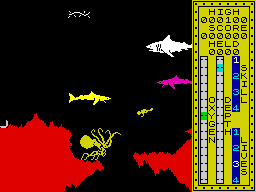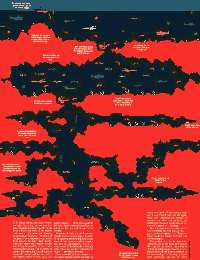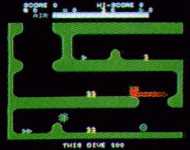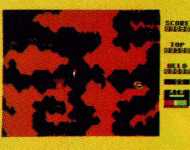created. There is a 'bottom', but supply
of oxygen seems the only limitation to
how far you can swim either way.
Author Mike Richardson has done
games players proud with Scuba. The
game was tested on a 48K Spectrum
using the keyboard controls; if you want
to use a joystick, then the keys can be
programmed to suit. And in addition to
the major plus point of offering programmable control keys is the facility of
being able to SAVE and LOAD score
tables. All publishers please note!
Four skill levels are available, '1'
being the easiest and '4' the most difficult.
At level '4' the sea is thick with sharks,
squid and all the rest. Three divers are
available for play at the start, but a
bonus diver joins the party on board the
boat if one of the others manages to gain
access to the caves containing treasure
chests.
Play is started by touching the Space
key. As the diver enters the water, the
first problem is to get him safely away
from the hull, because if there aren't
lethal jellyfish floating on the surface,
then he can always kill himself on the
bottom of the boat.
Collecting oyster pearls is a matter of
waiting until the oyster opens and then
touching it with the diver; there's a
maximum value of pearls and treasure
he can carry, which varies according to
the skill level of play. But whatever the
value, it's not added to the score until
the goodies are stashed safely back on
the boat. This is probably the most
frustrating part of the game. You could
be holding the maximum value allowed
and just by touching a rock you've
knocked your diver unconscious and
everything's gone.
Once you've mastered the rotate controls (à la Asteroids), the first real
challenge is to negotiate the tentacles of the
first octopus as it stands guard over an
undersea cave system. The caves are
home to dangerous sea creatures and
giant clams containing yet more valuable pearls. But beware ... the clams
can knock a diver unconscious if you' re
not careful. And another giant octopus
guards the entrance to yet another cave
system - one where the diver can help
himself to treasure from glowing chests.
There are three distinct levels to the
game, each growing progressively more
difficult The first involves gathering
oyster pearls and returning them to the
boat, and for the second, you must
negotiate an octopus and gather up clam
pearls (then re-negotiate the octopus
and return to the boat); finally, having
done all that, it's time to get into the
lower cave complex. Anyone making it
that far deserves that the surprise awaiting them stays as a surprise - sorry, but
my lips are sealed!
Naturally while all these activities
are going on, the diver's oxygen is
|
|
| These figures provide the player with an indication of the highest score achieved to date, the current score and the number of points actually held by the diver below the surface.
|
| A giant clam - watch out for opening time!
| 
| Depending on which skill level your diver is on, the relevant number is illuminated.
|
| The giant octopus. To go down to the caverns below, you must position your diver carefully so that when the octopus raises its legs, he can slip quickly between the gap.
| The number of lives you have left. You begin the game with only three divers, but you can gain a fourth simply by negotiating the first giant octopus.
|
|
| This column shows you how much oxygen there is left in the diver's tank. Once it gets near zero, you'd better hurry back to the boat for more - if you can find the boat that is!
| This column provides an indication of the depth your diver has reached.
|
|
|
|
gradually running out, although every successful return to the boat will have
replenished his supply. That sounds easy
enough until you discover that the boat
has drifted from its original position,
and you may just have some difficulty in
finding it again on returning to the surface.
And that's the game ... frustrating,
exasperating and totally addictive.
No doubt some genius (perhaps Mike
Richardson himself) will bring even
greater realism to computer animation
in the future, for the Scuba Dive experience is somewhat akin to the
enjoyment people had when the first Mickey Mouse cartoons came flickering onto
the silver screen.
Managing Director of Durell, Robert
White, says that many hours of hard
discussion went into the decision not to
give the diver any form of weapon; that
|
decision was right ... it makes the game
more exciting to play.
It's a program which gets away from
the wham-bam, mainstream arcade
games while still providing an entertaining scenario with graphics which
will not pall. Perhaps it's not a game for
the seven- to ten-year olds, although it
does have periods of frenetic activity.
But on the other hand, nor does it need
great intellectual skill to understand and
operate; Scuba simply requires sharp
reactions and a high degree of manual
dexterity. Ultimate success in getting
your diver back on board the boat, totally
against the odds and loaded with treasure,
is immensely satisfying and it can easily
take an hour or so to accomplish.
And more than anything, Mike
Richardson and Durell Software have
provided another important target for
the software writers to aim for and
improve on. For that reason alone it's
worth buying it to see what all the fuss is
about.
|



